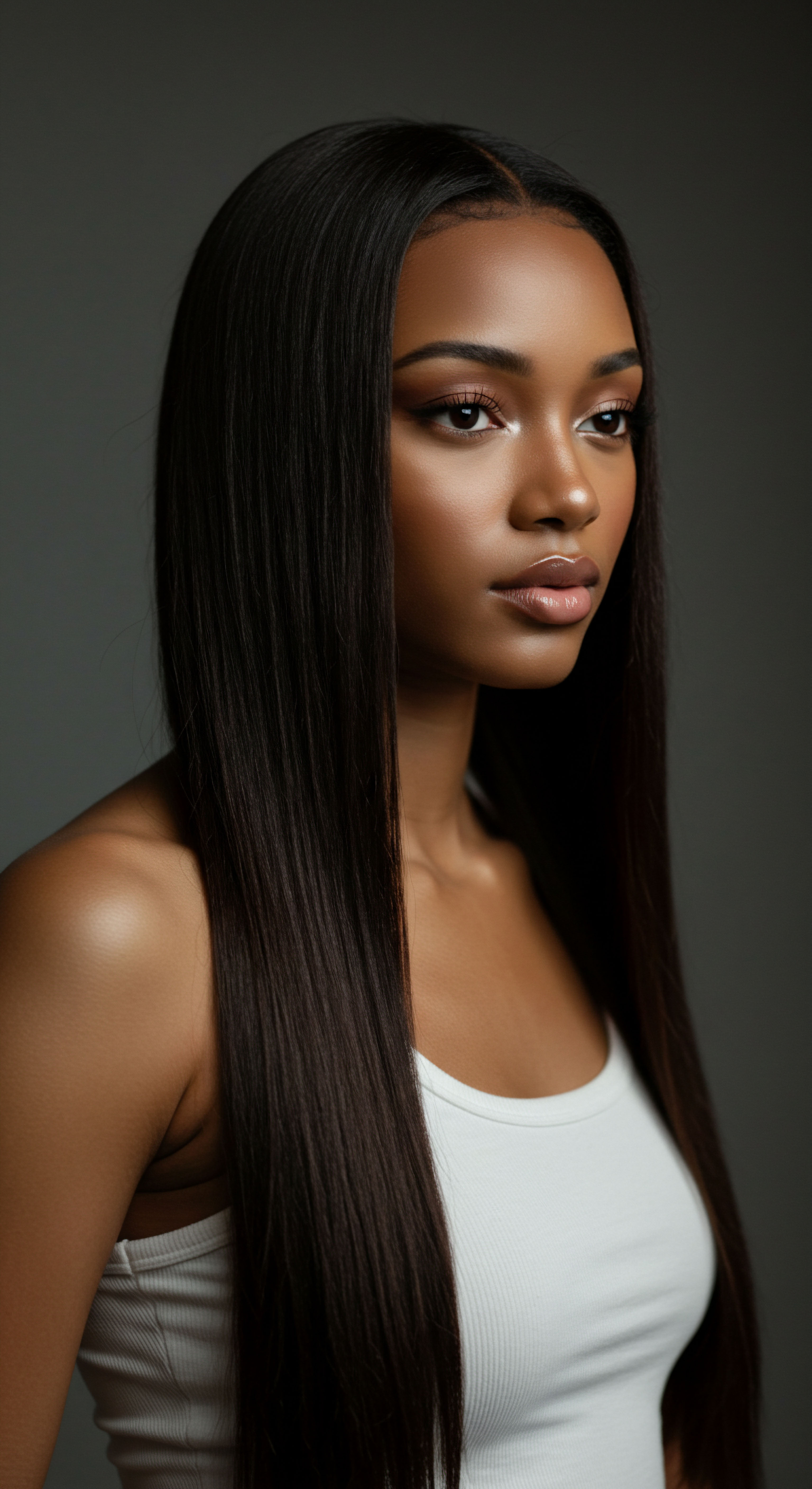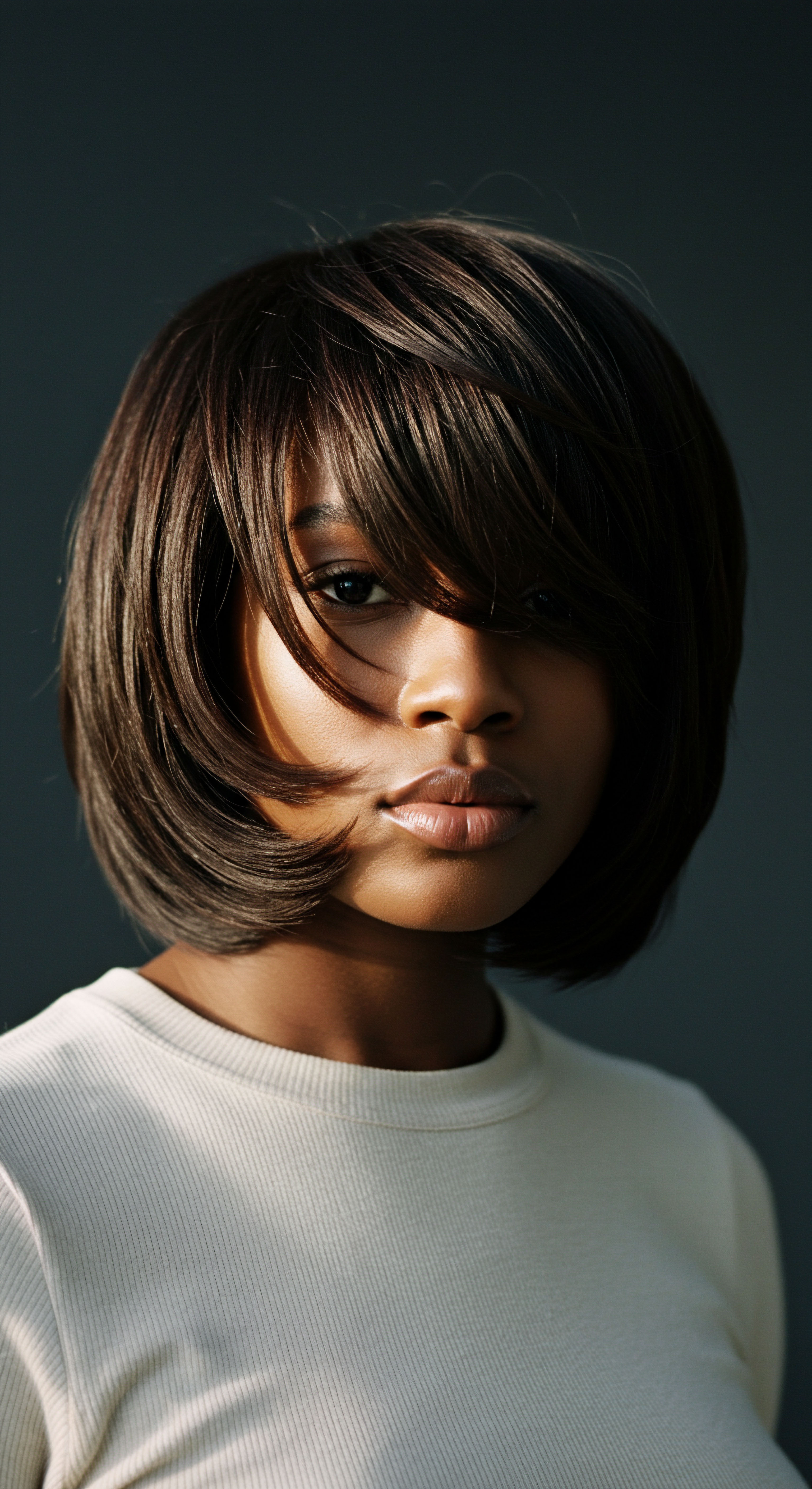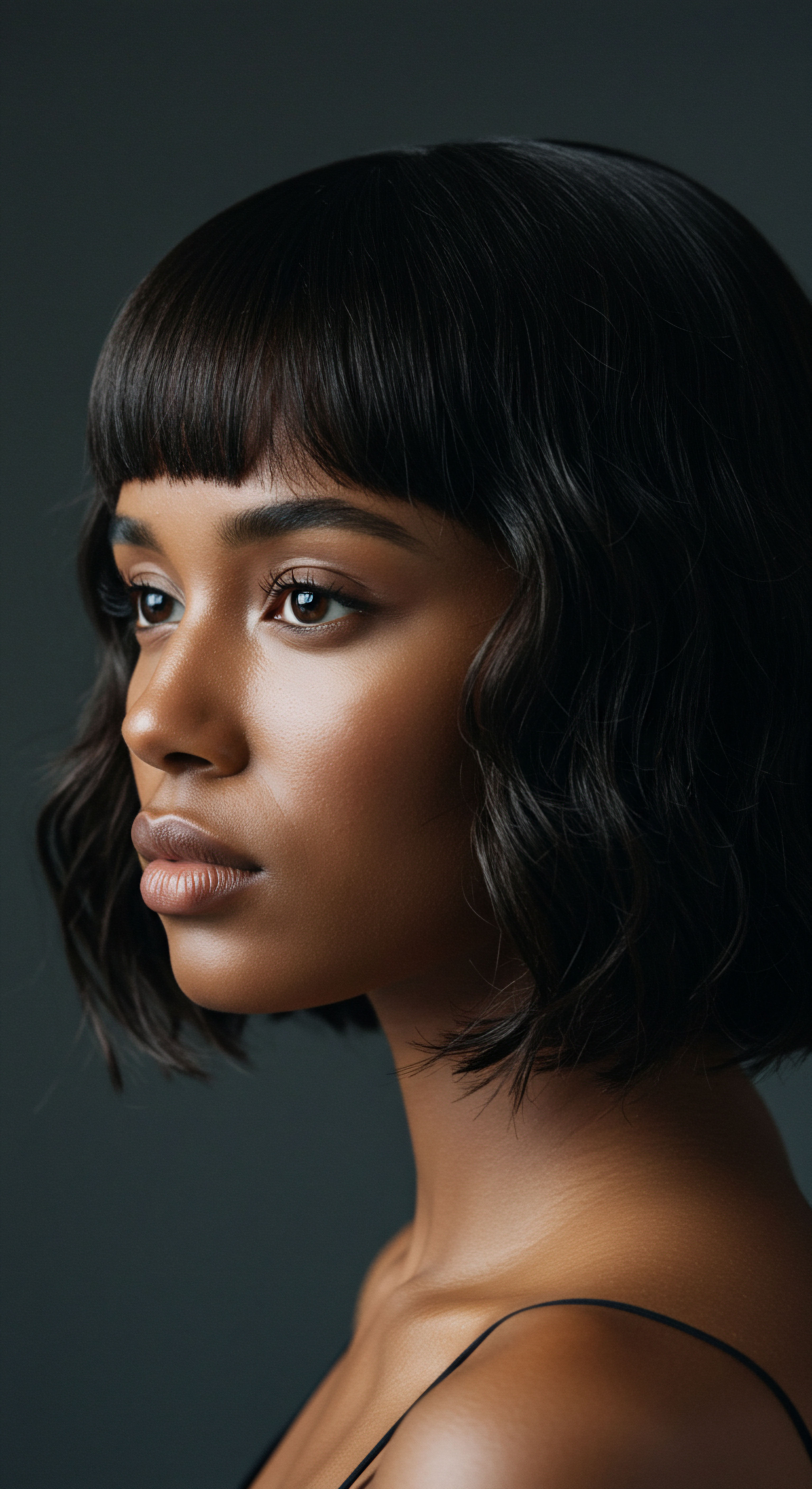
Roots
The sun-drenched sands of ancient Egypt held a profound sway over daily existence, shaping not only grand architectural marvels but also the quiet, personal routines of its people. Among these intimate practices, hair care stood as a remarkable testament to human adaptability, a delicate dance with a harsh desert climate. The scorching sun, the relentless dry winds, and the ever-present fine dust of the land presented unique challenges for maintaining healthy hair. This constant environmental pressure compelled ancient Egyptians to develop sophisticated methods, turning simple acts of grooming into a sophisticated system of protection and adornment.
Consider the daily realities ❉ the sun’s unyielding glare, capable of stripping moisture and degrading the very structure of hair. Then, the desert winds, carrying abrasive sand particles, could cause physical damage and irritation to the scalp. This environmental reality meant that hair, left unprotected, would become brittle, prone to breakage, and dull in appearance.
For a civilization that valued cleanliness and aesthetic presentation, these conditions spurred ingenuity. Their responses, far from being mere vanity, represented a deep understanding of environmental stressors and the biological needs of hair, even if their scientific language differed from our own.

What Did the Egyptian Climate Demand of Hair?
The ancient Egyptian landscape, dominated by arid conditions, presented a stark reality for human hair. Low humidity levels meant constant moisture evaporation from the hair shaft. This process, known as desiccation, leads to hair becoming dry, stiff, and more susceptible to mechanical damage.
The sun’s ultraviolet radiation, a silent aggressor, worked to break down the protein structures within hair, leading to a loss of elasticity and color fading. The sheer volume of airborne sand and dust acted as a physical irritant, settling on the scalp and coating strands, demanding regular cleansing.
To cope with these persistent environmental factors, the ancient Egyptians devised solutions that offered both protection and maintenance. Their hair care practices illustrate a remarkable awareness of how external conditions impact hair health. These solutions ranged from practical coverings to the application of various natural substances, each serving a specific protective or restorative function.
Ancient Egyptian hair care practices reflect a profound adaptation to the harsh desert climate, emphasizing protection, moisture, and cleanliness.

The Sun’s Silent Damage to Hair
The sun in ancient Egypt was not simply a source of light and warmth; it was a powerful force that could degrade organic materials, including human hair. Prolonged exposure to intense solar radiation causes a process called photodegradation. This breaks down the keratin proteins that compose hair, leading to a loss of tensile strength and increased porosity. Hair would become weaker, more prone to splitting, and less able to hold moisture.
Pigments within the hair could also bleach or alter, affecting natural color. This environmental stress meant that preventative measures against sun damage were not a luxury but a fundamental component of maintaining healthy hair.
- Hydration ❉ The desert’s dry air necessitated constant moisture replenishment to prevent brittleness.
- Protection ❉ Shielding hair from direct sun and abrasive sand was a daily concern.
- Cleanliness ❉ Frequent dust and sand accumulation required effective cleansing methods.

Ritual
Stepping from the foundational understanding of the desert’s impact, we turn now to the daily and periodic practices that formed the core of ancient Egyptian hair care. These routines, far from being perfunctory, reveal a sophisticated approach to beauty and well-being, deeply intertwined with the environmental realities of their world. The actions taken, the substances employed, and the very styling choices made, all tell a story of careful attention to hair health under challenging conditions. It is in these rituals that we see ancient ingenuity at its most practical and most graceful.
The dry air and constant dust meant that maintaining hair’s moisture and cleanliness was a persistent task. Egyptians utilized a range of natural oils and fats to coat and protect their hair, creating a barrier against the elements. These substances not only conditioned but also provided a subtle sheen, a visual marker of health and care. Furthermore, styling choices often prioritized containment and protection, reducing hair’s exposure to the environment.

What Hair Practices Protected Against the Desert?
Ancient Egyptians employed a variety of methods to protect their hair from the desert climate. A common practice involved the use of natural oils and animal fats. These substances, such as Castor Oil, Moringa Oil, and almond oil, were applied to the hair and scalp, forming a protective layer against the dry air and sun.
This practice served to moisturize the hair, reduce evaporation, and add a healthy luster. Archaeological findings, including analysis of mummy hair, support the widespread use of these fatty substances.
Another significant adaptation was the widespread adoption of wigs and hair extensions. Wigs offered a practical solution to several climatic and hygienic concerns. They provided a layer of insulation against the sun’s direct heat while allowing the wearer to keep their natural hair short or shaven underneath, aiding in cooling and preventing lice infestations. These elaborate hairpieces, often made from human hair or plant fibers, were not simply decorative; they were functional garments tailored to the Egyptian environment.
Ancient Egyptians skillfully used natural oils, fats, and intricate wigs to shield their hair from the desert’s dryness and sun.

The Role of Wigs and Hairpieces
Wigs were a cornerstone of ancient Egyptian hair care, serving multiple purposes beyond mere aesthetics. They offered a significant advantage in managing hair in a hot, dusty environment. By shaving or cropping their natural hair, individuals could maintain cleanliness and reduce the likelihood of parasitic infestations, a persistent concern in ancient societies.
The wig then provided a fashionable and protective covering. Elite individuals, in particular, favored complex wigs, often made from human hair, which could be quite costly.
These hairpieces were constructed with a mesh-like foundation, allowing air circulation and heat escape, making them surprisingly comfortable despite the warm climate. Wigs also allowed for elaborate hairstyles that would be difficult to maintain with natural hair in such conditions, or that signaled social status.
| Substance Castor Oil |
| Primary Benefit Moisturizing, growth promotion |
| Source Plant seed, |
| Substance Moringa Oil |
| Primary Benefit Lightweight conditioning, scalp health |
| Source Plant seed |
| Substance Almond Oil |
| Primary Benefit Moisture retention, elasticity |
| Source Plant seed |
| Substance Animal Fats |
| Primary Benefit Styling hold, protection |
| Source Various animals, |
| Substance Henna |
| Primary Benefit Dyeing, conditioning, strengthening |
| Source Lawsonia plant leaves, |
| Substance These ingredients formed the basis of many ancient Egyptian hair preparations. |

How Did Egyptians Maintain Hair Cleanliness?
Cleanliness was paramount in ancient Egypt, not only for personal comfort but also for religious and social reasons. The desert’s dust and sand would quickly accumulate in hair, making regular washing a necessity. While specific “shampoos” as we know them did not exist, Egyptians used alkaline substances like natron, a naturally occurring salt, sometimes mixed with water, for cleansing purposes.
Plant extracts and various oils would also have played a role in keeping hair and scalp clean and healthy. The practice of shaving the head and wearing wigs also greatly simplified hygiene, reducing the surface area for dirt and parasites to cling to.
Archaeological discoveries of combs made from wood, bone, and ivory dating back to predynastic times attest to the consistent effort put into detangling and cleaning hair. These tools were essential for distributing oils and removing accumulated dust, contributing to both the appearance and health of the hair.

Relay
Moving beyond the practical routines, we now turn to a deeper understanding of how the desert climate’s influence on Egyptian hair care extended into societal structures, scientific observations, and the very perception of beauty. This layer of exploration reveals a civilization that did not merely react to its environment but actively integrated its challenges into a sophisticated cultural framework. Here, we consider the less apparent complexities, the interplay of environmental necessity with social aspirations and nascent scientific inquiry, to gain a more complete picture of this ancient connection.
The drive for solutions against environmental harshness prompted innovations that served dual purposes ❉ health and status. The elite’s ability to afford elaborate wigs, for example, underscored not only their wealth but also their capacity to maintain an idealized appearance in a climate that made such maintenance challenging for others. This cultural valuing of hair health, spurred by environmental factors, permeated various aspects of Egyptian life, from daily grooming to funerary preparations.

Did Hair Treatments Serve More Than Cosmetic Ends?
The application of treatments to hair in ancient Egypt often transcended simple cosmetic appeal, holding deeper practical and even ritualistic significance. Beyond styling, many preparations were designed to protect hair from the desert’s damaging effects. For instance, the fatty substances used as styling agents also served as a barrier against sun and dryness.
Research on hair samples from mummies, including those excavated from the Dakhleh Oasis, has shown the consistent presence of a fat-based “gel” containing biological long-chain fatty acids like palmitic and stearic acid. This substance not only held hairstyles in place but also acted as a conditioning agent, preserving hair structure in the dry climate, even in death.
Consider the broader implications ❉ a well-maintained head of hair, whether natural or a wig, signaled cleanliness and health in a time when hygiene was a constant battle against environmental factors. Priests, for example, often shaved their heads entirely to maintain ritual purity, avoiding lice and other impurities that hair could harbor. This practice, directly linked to the hot climate and concerns about infestation, highlights how environmental pressures shaped religious and social norms around hair.
Egyptian hair practices blended aesthetic goals with critical protective and hygienic functions, driven by desert conditions.

Hair as a Barometer of Social Standing
The appearance of hair, and the care invested in it, served as a clear indicator of social status in ancient Egypt. While commoners working outdoors often wore their natural, short hair, the elite indulged in elaborate wigs and hair extensions. These artificial hairpieces, crafted from human hair or plant fibers, required significant resources to acquire and maintain, making them a symbol of wealth and leisure.
A study by Joann Fletcher, examining ancient Egyptian wigs, points out that the earliest known hair extensions date to approximately 3400 BCE from Hierakonpolis. Complete wigs were more costly, largely restricted to the elite. The very ability to maintain a shaven head underneath a wig, thereby avoiding environmental damage and infestations, was a privilege of status. The quality of a wig, its length, and its adornments, like gold rings or beads, further distinguished the wearer within the social hierarchy.

Unconventional Hair Remedies and Their Basis
The ancient Egyptians also developed a range of remedies for hair loss and scalp conditions, some of which appear quite unusual to modern sensibilities but reflect their observational knowledge. Medical papyri, such as the Ebers Papyrus dating to 1550 BCE, document various concoctions aimed at promoting hair growth. These included mixtures of fats from diverse animals like hippopotamus, crocodile, tomcat, snake, and ibex. While seemingly bizarre, these animal fats likely provided lipids and other nutrients that could moisturize the scalp and hair, possibly offering some conditioning benefit, even if the specific animal source was chosen for symbolic or perceived medicinal properties rather than proven efficacy.
One particularly intriguing aspect of ancient Egyptian hair science involves their understanding of natural dyes. Henna, derived from the Lawsonia plant, was widely used to color hair, particularly to cover grey strands, and also provided conditioning properties. This practice, still common today, shows a long-standing appreciation for natural solutions.
A study published in the Journal of Archaeological Science examined hair samples from 18 mummies, finding that a fat-based substance was applied to hair to maintain styles. This substance, identified as containing long-chain fatty acids, was found on both naturally preserved and artificially mummified bodies, indicating its use in life and in death. This suggests a practical understanding of how to preserve hair’s appearance and structure, a knowledge that directly countered the desert’s drying effects. The application of such substances, designed to prevent the hair from becoming dry and brittle, allowed styles to remain intact for millennia.
- Wigs ❉ Provided protection from sun and dust, allowed for cleanliness of natural hair underneath.
- Oils and Fats ❉ Acted as moisturizers, conditioners, and styling agents against dryness.
- Styling Techniques ❉ Braids and compact styles reduced exposure and tangling from wind and sand.

Reflection
The enduring legacy of ancient Egyptian hair care, born from the crucible of the desert, reminds us that true innovation often arises from direct environmental challenges. Their sophisticated responses to dryness, sun, and sand were not mere aesthetic whims but deeply considered adaptations, shaping practices that resonate even today. We see in their efforts a profound respect for personal presentation, a drive for hygiene, and a resourceful spirit that turned natural resources into solutions for hair health. The silent lessons of the desert, inscribed in the archaeological record, continue to whisper truths about resilience and ingenuity, offering a timeless perspective on caring for our crowns.

References
- Fletcher, Joann. “Ancient Egyptian Hair and Wigs.” Internet Archaeology, no. 42, 2016.
- Fletcher, Joann. Hair ❉ Styling, Culture and Fashion. Thames & Hudson, 2004.
- Lucas, Alfred. Ancient Egyptian Materials and Industries. Edward Arnold & Co. 1962.
- McCreesh, Natalie C. et al. “Ancient Egyptian hair gel ❉ New insight into ancient Egyptian mummification procedures through chemical analysis.” Journal of Archaeological Science, vol. 38, no. 11, 2011, pp. 2843-2849.
- Robins, Gay. “Hair, Gender, and Social Status in Ancient Egypt.” Journal of the American Research Center in Egypt, vol. 56, 2020, pp. 1-14.
- Tassie, Geoffrey J. The Social and Ritual Contextualisation of Ancient Egyptian Hair and Hairstyles from the Protodynastic to the End of the Old Kingdom. University College London, 2009. (Doctoral thesis)
- Riefstahl, Elizabeth. Ancient Egyptian Hairdressing. Brooklyn Museum, 1952.
- Manniche, Lise. An Ancient Egyptian Herbal. University of Texas Press, 1989.
- Nunn, John F. Ancient Egyptian Medicine. University of Oklahoma Press, 2002.